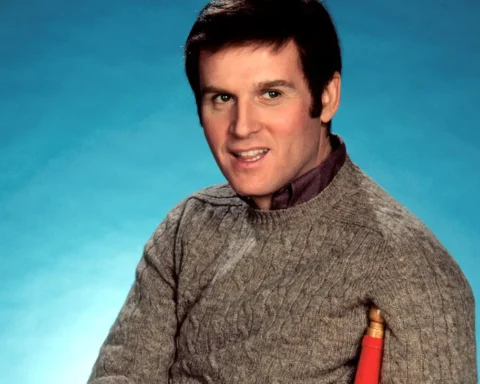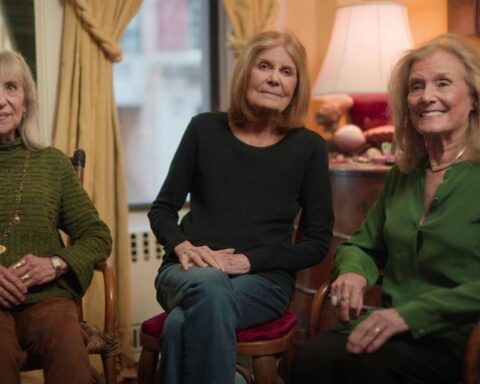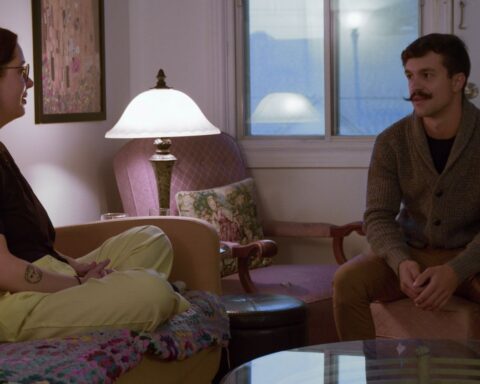Made in England: The Films of Powell and Pressburger
(UK, 131 min.)
Dir. David Hinton
Programme: Special Presentations (Canadian premiere)
As Martin Scorsese recalls in the opening scene of Made in England: The Films of Powell and Pressburger, it was The Thief of Baghdad that got him hooked. The great director tells how developing asthma at a young age inspired him to tune into movies on the TV. The 1940 adventure directed by Michael Powell, Ludwig Berger, and Tim Whelan enchanted him unlike anything else even though it was in black and white and poorly framed. Anyone who has seen a Michael Powell film knows that an ill-formatted small screen isn’t ideal for his movies: they demand the theatrical experience to really let their colourful images pop.
Nevertheless, Scorsese thrall is palpable. This is a movie for people who love movies, and Scorsese invites cinephiles to join him on a deep dive into the filmography of Michael Powell and Emeric Pressburger. As Scorsese often says, the directors’ films, especially Powell’s, proved deeply influential on his own “pictures.” Made in England, directed by David Hinton, and offers an engaging master class on three of cinema’s titans. It’s a true must-see for film buffs who dream in Technicolor
Scorsese narrates the film in a direct-address to the camera. Reading mostly off a teleprompter but at his best when speaking off the cuff, Scorsese recaps how Powell and Pressburger had an impact on him. Especially influential was The Red Shoes, their Oscar-winning 1948 masterwork that’s probably their most highly regarded film. (It’s my personal favourite, anyway.) Scorsese notes the sense of awe he felt while being transported through the film’s rich sense of fantasy and psychology as it told the story of a dancer possessed by her passion and a pair of ballet slippers that wouldn’t quit. He tells how Powell and Pressburger’s rich shocks of colour informed his own use of red.
Moreover, he adds that the burgeoning class of new wave American filmmakers of which he was a part—people like Francis Ford Coppola, Brian De Palma, and Stanley Kubrick—were all watching Powell and Pressburger films while learning their craft. However, Scorsese notes, it seemed that the British didn’t afford the duo the same respect.
Scorsese recalls seeking out Powell in England shortly after making Mean Streets and learning that the director was in seclusion, barely able to keep his lights on. After meeting in a pub, a friendship formed as Powell attributed the conversation for revitalising him. Scorsese says he invited Powell to see Mean Streets, which the elder filmmaker felt had too much red. Ever the respectful protégé, Scorsese laughs that he kept Powell’s influence mum.
As Made in England charts the impact and influence of Powell and Pressburger’s work, Hinton and Scorsese start from the beginning. The film tells how Powell honed his craft churning out “quota quickies” prior to his collaboration with Pressburger. Making 20 of these cheap B-movies on tight turnaround gave Powell lots of experience, especially in terms of making movie magic with limited resources. A hefty sequence on The Phantom Light affords the 1935 film more consideration than the past few decades’ of film criticism combined. However, this attention to the full filmography is what really makes Made in England sing.
Hinton and Scorsese don’t restrict the journey to a Film 101 class on The Archers’ greatest hits. The documentary affords equal weight to nearly every title in the duo’s collaborative oeuvre. Hits like Black Narcissus and The Red Shoes receive as much airtime as flops like The Elusive Pimpernel and Oh…Rosalinda. Scorsese dives into what makes each film thrive or flounder. Moreover, the study smartly situates the duo’s films within the larger cultural and industrial contexts of their production. It illuminates how they elevated Britain’s propaganda machine of wartime moviemaking, but later struggled to realise their distinct visions while gambling with Hollywood titans like David O. Selznick for lavish productions like Gone to Earth.
With extended sequences on so many films, Made in England admittedly drags in some cases. Hinton and Scorsese could probably conflate analysis of a few similar films if they wanted to. However, they find little repetition and carefully use each film to explore a different facet of The Archers’ oeuvre.
Some really rich sequences fly by, like when the film gets to Black Narcissus and The Red Shoes, which illustrate how Powell developed a style for “composed films.” Both films feature memorable dialogue-free sequences that use the visual power of cinema to engage a viewer. These sequences draw upon techniques of silent cinema and Made in England practically offers a crash course in film history from its inception to present. Scorsese tells how some of these very sequences inform scenes in films like Raging Bull, cut masterfully by Powell’s wife, Thelma Schoonmaker.
Equally fine are the explorations of The Life and Death of Colonel Blimp and A Matter of Life and Death. The former looks at elements of The Archers’ filmography, like their fearless deconstruction of the British class system and their strong relationship with actors in the former, and their grand sense of visual scale and dreamy use of colour in the latter. For people who love classic cinema, there are few better deep dives than this one.
Made in England shows how any film—masterpiece or misfire—becomes richer when studied and understood in the context of its production. There’s a great discussion of authorship, too, as Powell and Pressburger unpack who did what in their films, noting that they always shared credit, but that Powell did more of the directing and Pressburger more of the writing. Yet these films are distinctly collaborative in a way that few bodies of work are. Clips from Saturday Night at the Movies with Elwy Yost, that old TVO staple, afford the filmmakers a say on their own work.
Moreover, Scorsese’s appraisal of The Archers, as well as the documentary’s eagerness to consider works both major and minor, invites audiences to consider which artists deserve a place in the artistic canon and might equally benefit from reappraisal, as Powell and Pressburger did in their careers. One hopes to see more docs like this one that offer worthy voices more consideration. See it on the biggest screen you can.
Made in England: The Films of Powell and Pressburger screens at Hot Docs 2024.
Update: The film opens at TIFF Lightbox on July 26.














